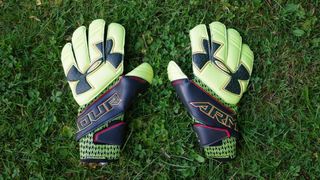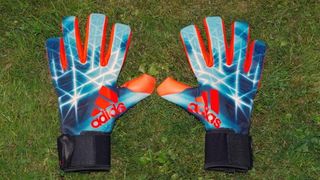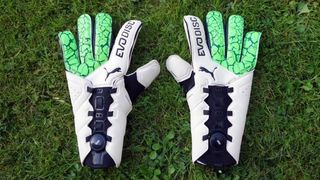The Best Goalkeeper Gloves
Find out the results of our hands-on test, plus what to look for in a pair of goalkeeper gloves
It takes a special kind of person to want to be a goalkeeper. Choosing to hurl yourself in front of a ball that has been pelted goalwards defies good sense (see: the cowardly way defenders turn away when “blocking” shots), but there’s something admirable in being that last line of defence (just keep telling yourself that, it might come true). If you’ve decided to put your body on the line, you’re going to need all the help you can get – and the right pair of goalkeeping gloves can make a big difference.
Like all sports equipment, be it football boots or cricket bats, the right choice might not be the most expensive thing you can afford. Different gloves suit different players – you might prefer a lightweight pair to aid quick hand movements, sticky palms to help with catching or a thicker pair to give you the confidence to throw yourself at the biggest strikers’ feet.
To help you make a decision, we’ve tested five of the most popular pairs and explained what sets them apart, and below that we run you through the ways in which goalkeeper gloves can differ and recommend some of our favourites.
All of our picks have been tried and tested – thoroughly, shout-out to all the players who don’t bother tracking back – in Coach’s lunchtime five-a-side league.
Best Goalkeeper Gloves
Under Armour Desafio Premier

At first glance there’s a distinct lack of fancy features on these gloves (but bear with us, there are always fancy features). The design is a standard box cut without even negative stitching so you’d expect them to be quite loose around the fingers and not very responsive. However, as soon as you slip them on you realise there’s something going on under the surface that makes these gloves fit far better than you would expect.
Under Armour has included two features that contribute to this enhanced fit and flexibility: finger lock construction and ClutchFit (the latter refers to the American sporting cliché meaning crunch time, rather than changing gear in a car). The finger lock tightens the space for each finger while the clutch wrist support wraps around the wrist from a point halfway between the thumb and wrist. This means that when you strap it up, it pulls not only around the wrist but also down the hand. The result is a snug glove that feels responsive and should also be more hard-wearing than its negatively stitched rivals.
The palm is a 4mm latex foam that provides a lot of grip and the fingers are stiff enough to provide support without impeding movement. £110, buy on underarmour.co.uk
Adidas Ace Trans Pro

If you’re after a glove that fits like a, well, glove then this is the pair for you. Worn by the likes of Manuel Neuer, Iker Casillas and David de Gea, the Adidas Trans Pro certainly comes with professional pedigree. It feels light and flexible, but it’s not big on protection.
The glove uses a negative cut to provide a close fit to the hand, with a cut between the palm and thumb for a tight and responsive fit. This lends a feeling of control but on the other hand makes it a tad lightweight, and it’s not optimised for grip.
The back of the glove does have rubber sections to help give punches some power, and these are segmented so the glove can still flex, offering a bit of resistance but not heavy protection. £79.95, buy on adidas.co.uk
Puma EvoDisc

As worn by Petr Cech, the EvoDisc is the first to use a disc as a fastener. Instead of straps, the glove has have a wire down the back of the hand which works like a shoelace to fix the glove to the hand. The fit can then be tightened or loosened by turning the disc.
In theory this sounds like a good idea, although in practice turning these dials while you have the gloves on is pretty difficult. We took to tightening first and then trying to squeeze into the gloves. This meant it didn’t feel as tight as some others, particularly at the wrist, although the ability to tighten the body of the glove as well means it feels secure and better fitted to other parts of your hand.
Having the fastening on the back of the glove also allows the latex to run down the wrist, increasing the area that affords grip. In fact, the glove is pretty much a huge piece of latex rolled around your hands so you have the maximum grip not only around the fingers but also the side of the hands and wrist. If you can’t catch a ball with these gloves, you can’t catch a ball.
The back of the glove is a bit more robust than the latex on the palm and although it doesn’t offer a lot in terms of protection, it is fine for getting a decent punch on a ball. £120, buy on uk.puma.com
RECOMMENDED: The Best Five-A-Side Football Boots
Umbro Neo Pro Shotgun

This glove from Umbro uses a combination of cuts: negative finger rolls for the index and middle finger, and a negative cut for the remaining two fingers. This increases the grip, especially when combined with the latex rolled around the thumb, and grants greater movement to the last two fingers to help get a handle on the ball quickly.
The back of the glove includes a firmer, padded “3D punch zone” for getting distance on punches, and the back of the glove provides support for the thumb and first two fingers. The final two fingers are left relatively unsupported, but this does go a long way to allowing freedom of movement.
The Neon Pro Shotgun feels like a solid, unfussy option, providing a good mix of protection and flexibility. £80, buy on umbro.co.uk
Nike Grip3

If you’re looking for a pair of training gloves or just don’t want to spend too much on your match gloves, this pair from Nike is a good bet. The box cut for the middle two fingers and a roll cut for the index and fifth finger are a more traditional combination than the others on our list.
It doesn’t lie as close to the hand as a negative cut glove, but notches around the thumb and either side of the knuckles mean the palm side bends easily to the hand without sacrificing any thickness.
The colours may not be for everyone – the grape purple around the wrist is particularly bold – but have you seen the colourways strikers think they can get away with these days? Fashion aside, this is a no-nonsense pair for a reasonable price. £34.99, buy on dwsports.com
What To Look For In A Pair Of Goalkeeper Gloves
The way a glove is constructed plays a big part in its shape and fit, the grip and the level of protection offered, as well as how long they’re likely to last. Each cut has its benefits and drawbacks; the right choice for you comes down to personal preference.
Box Cut
You can trust Coach
The box, or flat palm, is a traditional cut that today is mostly found at the cheaper end of the market. A single piece of latex for the palm and fingers is stitched to the back of the glove with gussets. Using gussets makes the glove tighter, but they don’t provide as much latex coverage which means they offer less grip than other cuts.
Negative Cut
A negative cut is similar to the box cut, but the gussets are stitched on the inside of the glove. This means the glove is tighter to the hand and provides slightly increased grip, although it will see wear and tear sooner than a glove with the box cut.
Roll Finger Cut
The roll finger or “gun” cut wraps the latex around the finger and connects it directly to the back of the glove. Not using gussets gives a bigger latex area, which improves grip, although it does mean the fingers aren’t as tight so it may not feel as fitted. This cut can also come with negative stitching on the inside of the glove to further increase the latex surface area, but again this means wear and tear occurs sooner.
Combination Cuts
Rather than sticking to a single finger style, some gloves use different cuts on different fingers to combine the benefits of different styles. For example, a glove may have a roll cut on the index and fifth finger of the glove to increase latex contact for catching, but a negative cut on the inside fingers to increase overall comfort and flexibility.
Size
Like shoes, gloves come in a range of sizes, generally between 4 and 12. While this sizing should be consistent, it can vary between brands, so it’s worth trying on a pair before you buy (or checking the returns policy when buying online) to ensure you have the right fit.
Glove sizes should correspond to the chart below. Measure at the knuckles, finding the greatest width.
| Glove size | Hand width (cm) |
|---|---|
| 4 | 4.5-5.1 |
| 5 | 5.1-5.7 |
| 6 | 5.7-6.3 |
| 7 | 6.3-6.9 |
| 8 | 6.9-7.5 |
| 9 | 7.5-8.1 |
| 10 | 8.1-8.7 |
| 11 | 8.7-9.3 |
| 12 | 9.3-10 |
RECOMMENDED: The Best AstroTurf Boots For Football
Palm Type
The material of the palm plays a huge part in the performance of the gloves. Professional players favour latex for increased grip, but this isn’t the most hardy of materials and will degrade over time. Rubber or a combination of rubber and latex will increase the lifetime of the gloves, and these are often better for training or playing indoors.
The thickness of the palm also plays a part, with thinner palms giving a better feel of the ball but less protection and cushioning. Most gloves come with a palm around 4mm thick, which is a good mid-point to start at if you’re unsure what suits you.
Finger Protection
Almost every brand now offers gloves with some form of finger protection, often featuring a plastic spine down each finger to prevent hyperextension injuries. These are a good option if you have suffered an injury in the past, but they don’t protect against more common injuries such as stubbed fingers or having your hand stepped on.
There is also an argument that if your fingers end up relying on the spines they become more susceptible to injury because they may not develop suitable strength. For this reason we would recommend avoiding these types of glove unless you have an existing injury.
Get the Coach Newsletter
Sign up for workout ideas, training advice, reviews of the latest gear and more.
